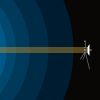3 Billion Year Old Wave
Just published.
On January 4th, 2017 scientists at the CalTech L.I.G.O detected the merger of two black holes 3 billion light-years away.
At 2:11:58 a.m. on January 4th 2017 the arms of LIGO’s Hanford, WA interferometer shivered. Three milliseconds later, Livingston’s interferometer followed suit. Even though parts of the U.S. were experiencing record cold temperatures, the trembling wasn’t caused by the frigid air of that winter morning. Rather, it was the shudder of space-time itself generated by the merger of two massive black holes in the distant universe: a gravitational wave had washed over the Earth, passing successively through the two detectors while most people in the U.S. were still asleep.
This marks the furthest detection they’ve been able to make and increases confidence that these events will be seen with increasing frequency as the LIGO interferometers become more sensitive to low amplitude gravitational waves (as sources of noise are eliminated).
Thanks to Derek at Veritasium


